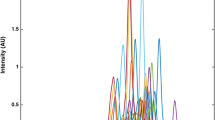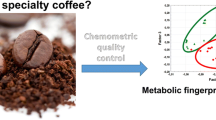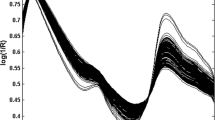Abstract
Roasting is one of the most influencing stages of coffee processing. Accordingly, a discriminant analysis (DA) was carried out with the objective of identifying key compounds (chemical markers) that enable a differentiation of coffee samples according to their roasting degree. For this, chromatographic data of the volatile fraction of 21 coffee samples submitted to distinct roasting treatments (Light, Medium, Dark, and French Roasts) were employed. Using three discriminant functions that rely on only ten chemical markers, it was possible to explain 100 % of the variance of the data points. If two functions are used, the surprisingly high value of 99.4 % is achieved. The model was cross-validated, and the main function successfully passed a permutation test using two statistical indicators. It was found that half of the markers belong to the pyrazines family, known to grant sensorial notes related to roasted hazelnut and peanuts. In the whole, this essay demonstrates the usefulness of DA as a tool to control the quality of roasting treatment of coffee and can be further extended with advantage to the eight roasting degrees of the AGTRON Roasting Classification as soon as larger databases become available.


Similar content being viewed by others
References
Akiyama M, Murakami K, Hirano Y, Ikeda M, Iwatsuki K, Wada A, Tokuno K, Onishi M, Iwabuchi H (2008) Characterization of headspace aroma compounds of freshly brewed arabica coffees and studies on a characteristic aroma compound of Ethiopian coffee. J Food Sci 73(5):335–346
Barbosa HMA, de Melo MMR, Coimbra MA, Passos CP, Silva CM (2014) Optimization of the supercritical fluid coextraction of oil and diterpenes from spent coffee grounds using experimental design and response surface methodology. J Supercrit Fluids 85:165–172
Campos-Vega R, Loarca-Piña G, Vergara-Castañeda HA, Oomah BD (2015) Spent coffee grounds: a review on current research and future prospects. Trends Food Sci Technol 45:24–36
Costa LL, Toci AT, Silveira CLP, Herszkowicz N, Pinto M, Farah A (2010) Discrimination of Brazilian C. Canephora by region using mineral composition. In: Proceedings of the 23rd International Coll on the Chemistry of Coffee, Bali
Damoradam S (2007) Amino acids, peptides and proteins. In: Fennema OR (ed) Food chemistry. Marcel Dekker, New York, pp 412–416
de Melo MMR, Barbosa HMA, Passos CP, Silva CM (2014) Supercritical fluid extraction of spent coffee grounds: measurement of extraction curves, oil characterization and economic analysis. J Supercrit Fluids 86:150–159
de Toledo PRAB, de Melo MMR, Pezza HR, Toci AT, Pezza L, Silva CM (2016) Discriminant analysis for unveiling the origin of roasted coffee samples: a tool for quality control of coffee related products. Food Control. doi:10.1016/j.foodcont.2016.08.001
Eggers R (2005) Roasting techniques. In: Illy A, Viani R (eds) Espresso coffee: the science of quality, 2nd edn. Elsevier Academic Press, London, pp 184–191
Franca AS, Oliveira LS, Oliveira RCS, Agresti PCM, Augusti R (2009) A preliminary evaluation of the effect of processing temperature on coffee roasting degree assessment. J Food Eng 92:345–352
Low JH, Rahman WAWA, Jamaluddin J (2015) The influence of extraction parameters on spent coffee grounds as a renewable tannin resource. J Clean Prod 101:222–228
Maeztu L, Sanz C, Andueza S, Paz De Peña M, Bello J, Cid C (2001) Characterization of espresso coffee aroma by static headspace GC-MS and sensory flavor profile. J Agric Food Chem 49:5437–5444
Agresti PCM, Franca AS, Oliveira LS, Augusti R (2008) Discrimination between defective and non-defective Brazilian coffee beans by their volatile profile. Food Chem 106:787–796
McLachlan G (2004) Discriminant analysis and statistical pattern recognition, vol 544. Wiley, Chicago, pp 168–211
Moeenfard M, Silva JA, Borges N, Santos A, Alves A (2014) Diterpenes in espresso coffee: impact of preparation parameters. Eur Food Res Technol 240:763–773
Moon JK, Shibamoto T (2009) Role of roasting conditions in the profile of volatile flavor chemicals formed from coffee beans. J Agric Food Chem 57:5823–5831
Morais SAL, Aquino FJT, Chang R, Nascimento EA, Oliveira GA, Santos NC (2007) Chemical analysis of Arabica coffee (Coffea arabica L.) and defective beans submitted to different degrees of roasting. Coffee Sci 2:97–111
Murota A (1993) Canonical discriminant analysis applied to the headspace GC profiles of coffee cultivars. Biosci Biotechnol Biochem 57:1043–1048
Nascimento EAD, Morais SALD, Rocha RS (2003) Constituintes voláteis de cafés “gourmet” e mole do cerrado do triângulo mineiro em função da torra. Ciência e Tecnologia de Alimentos 23:282–284
Powers JJ, Keith ES (1968) Stepwise discriminant analysis of gas chromatographic data as an aid in classifying the flavor quality of foods. J Food Sci 33:207–213
Ribeiro JS, Teófilo RF, Salva TDJG, Augusto F, Ferreira MMC (2013) Exploratory and discriminative studies of commercial processed Brazilian coffees with different degrees of roasting and decaffeinated. Braz J Food Technol 16:198–206
Rizzi GP (2006) Formation of strecker aldehydes from polyphenol-derived quinones and alpha-amino acids in a nonenzymic model system. J Agric Food Chem 54:1893–1897
Salinas-Vargas ME, Cañizares-Macías MP (2014) On-line solid-phase extraction using a C18 minicolumn coupled to a flow injection system for determination of caffeine in green and roasted coffee beans. Food Chem 147:182–188
Somporn C, Kamtuo A, Theerakulpisut P, Siriamornpun S (2011) Effects of roasting degree on radical scavenging activity, phenolics and volatile compounds of Arabica coffee beans (Coffea arabica L. cv. Catimor). Int J Food Sci Technol 46:2287–2296
Toci AT, Farah A (2014) Volatile fingerprint of Brazilian defective coffee seeds: corroboration of potential marker compounds and identification of new low quality indicators. Food Chem 153:298–314
Toci AT, Silva CM, Fernandes F (2014) Effect of roasting speed on the volatile composition of different quality coffee blends roasted in an industrial semi-fluidized bed roaster and in a small scale fluidized bed roaster. In: 25nd international conference on coffee science
Tsukui A, Santos Júnior HM, Oigman SS, de Souza ROMA, Bizzo HR, Rezende CM (2014) Microwave-assisted extraction of green coffee oil and quantification of diterpenes by HPLC. Food Chem 164:266–271
Vasconcelos ALS, Franca AS, Glória MBA, Mendonça JCF (2007) A comparative study of chemical attributes and levels of amines in defective green and roasted coffee beans. Food Chem 101:26–32
Westerhuis JA, Hoefsloot HCJ, Smit S, Vis DJ, Smilde AK, van Velzen EJJ, van Duijnhoven JPM, van Dorsten FA (2008) Assessment of PLSDA cross validation. Metabolomics 4:81–89
Whistler RL, BeMiller JN (1997) Carbohydrate chemistry for food scientists. Marcel Dekker, New York, pp 171–174
Acknowledgments
The authors thank the Brazilian National Research Council (CNPq) and the Coordination for the Improvement of Higher Level Personnel (CAPES) for financial support. This work was developed within the scope of the project CICECO-Aveiro Institute of Materials, POCI-01-0145-FEDER-007679 (FCT Ref. UID/CTM/50011/2013), financed by national funds through the FCT/MEC and when appropriate co-financed by FEDER under the PT2020 Partnership Agreement.
Author information
Authors and Affiliations
Corresponding author
Ethics declarations
Conflict of interest
The authors declare that they have no conflicts of interest.
Compliance with ethics requirements
This article does not contain any studies with human or animal subjects.
Rights and permissions
About this article
Cite this article
de Toledo, P.R.A.B., de Melo, M.M.R., Pezza, H.R. et al. Reliable discriminant analysis tool for controlling the roast degree of coffee samples through chemical markers approach. Eur Food Res Technol 243, 761–768 (2017). https://doi.org/10.1007/s00217-016-2790-1
Received:
Accepted:
Published:
Issue Date:
DOI: https://doi.org/10.1007/s00217-016-2790-1




